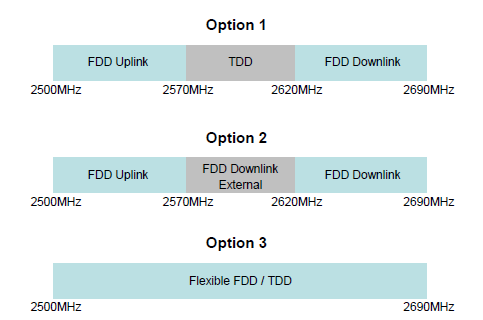This article is more than 1 year old
GSMA sees 2.6GHz future
Digs knife a little deeper into WiMAX
The GSMA argues that the majority of the 2.6GHz band should be LTE-friendly, conceding that WiMAX needs some space to play in the interest of neutrality.
The details come in a report (pdf) from the GSMA, the industry body representing GSM-based-mobile operators, which argues that 340MHz of the 2.6GHz band should be allocated on a Frequency Division basis - ideally suited to LTE - though it's prepared to see 50MHz handed over to the WiMAX crowd even if it ends up empty, as WiMAX itself probably won't last the age of the licence.
The band, which runs from 2.5GHz to 2.69GHz, was allocated (worldwide) for mobile communications back in 2000 when it was popularly expected that 3G services would expand there once 2.1GHz was full up with everyone making video calls. That didn't happen, but there is demand for more data now; so the International Telecommunications Union (ITU) has proposed three options for dividing up the bands between Frequency Division Duplex (FDD) and Time Division Duplex (TDD):

The difference lies in how handsets communicate with the network. In FDD systems one frequency is used for the uplink, and a different one for the downlink: that's how existing 3G systems work and LTE (the GSMA's preferred 4G technology) also uses it to provide easy coexistence with 3G. TDD systems use one frequency over which the base station and mobile take turns to speak; much like a traditional walkie-talkie. TDD is what the current version of WiMAX uses.
Obviously the GSMA would prefer Option 2, but that doesn't even pretend to be technology neutral so must be discounted. Option 3 would seem the most flexible, but FDD and TDD systems don't like to be too close to each other, and should neighbouring countries allocate the same spectrum to different multiplexing systems the result will be a right mess, so the GSMA is forced to recommend Option 1 while predicting that it will leave 50MHz of spectrum fallow.
And that's what some countries have already adopted, with the notable exception of the USA and Canada who forged ahead allocating spectrum before international agreements had been reached. In the USA that means TDD services, much to the disdain of the GSMA, which sniffily reckons that "at some point it may well become desirable to make better use of the 2.6GHz band in the United States than is represented by the current investments of Clearwire and Sprint Nextel".
In the UK 2.6GHz was supposed to have been auctioned off 18 months ago, but got caught up in a series of legal complications and delaying actions by the operators, and now it's part of the Digital Britain project. During that process the TDD allocation has been significantly reduced, and the UK now endorses Option 1 if Ofcom ever gets round to selling the block.
Ofcom is supposed to be technology neutral, but while the next version of WiMAX could use the FDD spectrum it's much better suited to LTE. So the way in which the spectrum is sold (in pairs or blocks) determines the technology for which it's best suited.
But Ofcom also carries the legacy of last time it did this, when 20MHz of spectrum was allocated to TDD services over the 3G networks. Every UK operator except Vodafone bought 5MHz of that spectrum and it still lies empty. The GSMA expects the same fate to befall the 50MHz of spectrum allocated to TDD at 2.6GHz, as WiMAX dies, but sees no way to avoid that outcome without giving up any pretence of technology neutrality. ®
